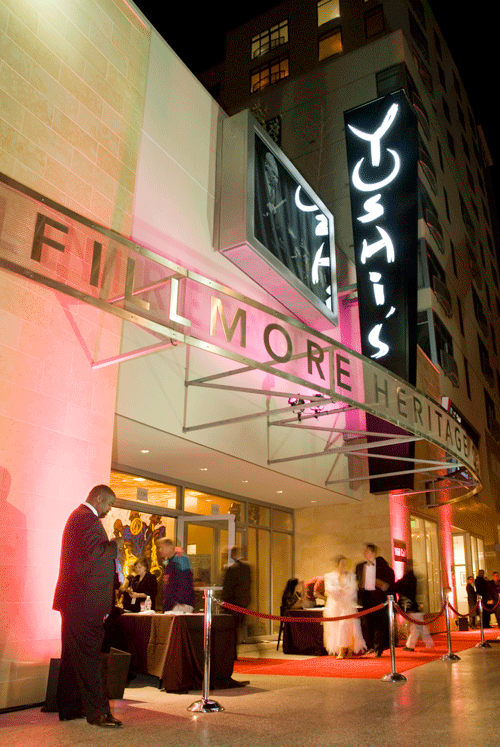ON ANY GIVEN NIGHT, Fillmore Street south of Geary is buzzing with street life. Stylish patrons make their way to 1300 on Fillmore for cocktails and dinner, or line up outside State Bird Provisions hoping for a coveted seat at what Bon Appetit magazine anointed as the best new restaurant in the country. Concertgoers head to the Fillmore Auditorium and Yoshi’s. Around the corner at Fat Angel and Social Study, a youthful clientele talks over drinks and snacks.
Five years after the opening of the cornerstone Fillmore Heritage Center in November 2007, lower Fillmore is finally getting its groove back.
“We’re bullish on the Fillmore,” says Jason Kirmse, one of the owners of the Fat Angel wine bar, who hopes to open another spot nearby.
Decades earlier, the Fillmore was the center of live music on the west coast — the “Harlem of the West” — with jazz joints such as the Primalon Ballroom and Jimbo’s Bop City lining the streets. Then came redevelopment, which razed 60 blocks in the historic Western Addition, and with it the cultural fabric of the neighborhood.
“In 2004, the neighborhood was still nearly a ghost town, with long stretches of empty storefronts and parking lots,” says longtime resident Gunther Bahrs.
Now that has mostly changed.
At the corner of Fillmore and Eddy — for decades an empty lot — the city finally stepped in and put up the funding to build the $74 million Fillmore Heritage project, which included 80 condos, Yoshi’s, 1300 on Fillmore and the Lush Life Gallery. It was a wager that if the restaurants and condos were successful, they would pave the way for others to join them.
The ground floor tenants — chosen for their jazz roots and the pedigree of their chefs — opened to rave reviews.
“We believed in our hearts the Fillmore would support an upscale, fine dining establishment in a neighborhood that was still trying to find its voice,” says Monetta White, who owns 1300 on Fillmore with her husband, award-winning executive chef David Lawrence. “If anyone was going to do it, it would be us.”
White’s deep ties to the neighborhood, where she lived as a child, were a pull for her. She and Lawrence not only opened a business in the neighborhoood, but moved there as well.
Even with additional backing from the city, 1300 and Yoshi’s struggled to pull in diners and music lovers, a task made more difficult by a deepening recession.
“When the recession hit, I’d lie if I didn’t admit it was a challenge,” says White. “We had to get creative to keep people coming back. But some of our best ideas came from our need to fill seats, including our Sunday gospel brunch, winemaker dinners, gumbo jams and live music nights.”
Kaz Kajimura, owner of Yoshi’s, also had to tweak his original business plan.
“We still believe jazz is the backbone of Yoshi’s brand,” he says. “But with the changing taste in music among the young people in the Bay Area, Yoshi’s music booking is also changing rapidly. Interspersed between the jazz names you now see R&B, fusion, pop, country, soul, world music, hip hop, you name it.”
He adds: “This is going to be the face of the new Yoshi’s, where people of different musical tastes gather for a night of good food and good music.”
A number of new businesses have opened in recent months on the stretch of Fillmore south of Geary. And with the economy gradually gaining strength, some of the more established venues are holding their own, including Rasselas, Sheba Piano Lounge, Gussie’s Chicken and Waffles and Bruno’s Pizzeria.
The jazz district, once attractive primarily to fast-food chains, has begun to attract other restaurants and bars. New casual spots include Holy Dog and Prime Dip sandwiches. In the coming months, Hapa Ramen is to open next door to State Bird Provisions, and Brenda’s Original Po’ Boy is expected next spring.
The neighborhood’s residential anchor, the Fillmore Center, has rebuilt its plaza and gardens, and now has low vacancy rates. It hosts the weekly Fillmore Farmers Market on Saturday mornings, but much of its commercial space has remained empty, even as new businesses were eyeing the area. Finally in September, San Francisco Gymnastics opened in some of the center’s empty storefronts.
Monetta White, who was appointed to the San Francisco Small Business Commission earlier this year partly in recognition of her championship of the jazz district, remains an enthusiastic booster of the neighborhood.
“The more small businesses we can entice to join our growing restaurant and entertainment hub, the better,” she says. “Through the ups and downs of the recession it’s been challenging, but now the future is looking bright for the lower Fillmore. But as much progress as we’ve made, there’s still so much room for growth in the next decade.”
Kaz Kajimura of Yoshi’s is measured in his assessment of the area’s progress.
“While Fillmore has made a significant leap forward as a good night out in recent years, it still has a long way to go compared to such areas as South of Market,” he says. “What we are lacking is a diversity of truly attractive establishments strong enough to draw people into this neighborhood.”
Filed under: Civics, Landmarks, Neighborhood History





